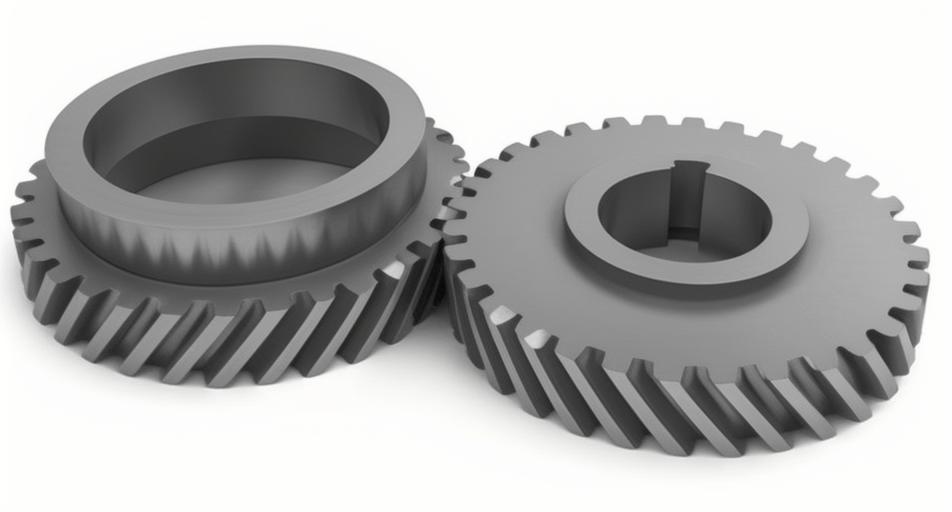
Precision helical gear play a crucial role in various industrial applications due to their ability to transmit power smoothly and efficiently. The manufacturing of these gears requires meticulous attention to detail to ensure high precision, durability, and performance. This article explores the optimization techniques used in the manufacturing process of precision helical gear, highlighting advancements in design, materials, and manufacturing technologies.
Key Optimization Techniques in Helical Gear Manufacturing
- Design Optimization:
- Finite Element Analysis (FEA): Utilizing FEA allows for the simulation and analysis of helical gear performance under various load conditions, enabling the identification of potential stress points and the optimization of helical gear geometry.
- Tooth Profile Modification: Adjusting the tooth profile to minimize stress concentrations and improve load distribution can significantly enhance gear performance. Profile modifications, such as tip relief and crowning, are commonly used.
- Helix Angle Adjustment: Optimizing the helix angle to balance load capacity and operational smoothness. Higher helix angles can improve load distribution but may increase axial thrust, requiring careful consideration.
- Material Selection and Treatment:
- High-Strength Alloys: Choosing high-strength steel alloys and other advanced materials to increase the load-bearing capacity and durability of helical gear.
- Surface Treatments: Applying surface treatments like nitriding, carburizing, and induction hardening to enhance wear resistance and extend gear life.
- Advanced Coatings: Utilizing advanced coatings such as Diamond-Like Carbon (DLC) and ceramic coatings to reduce friction and increase wear resistance.
- Manufacturing Technologies:
- Additive Manufacturing (3D Printing): Leveraging 3D printing technologies to produce complex gear geometries with high precision. This method allows for rapid prototyping and customization.
- CNC Machining and Grinding: Employing advanced CNC machining and grinding techniques to achieve high precision and surface finish. Precision grinding ensures accurate tooth profiles and reduces surface roughness.
- Automated Inspection Systems: Integrating automated inspection systems, such as coordinate measuring machines (CMM) and laser scanning, to ensure high-quality standards and detect any deviations from specifications.
Benefits of Optimized Helical Gear Manufacturing
- Enhanced Precision: Optimization techniques ensure high precision in helical gear manufacturing, resulting in improved performance and longevity.
- Increased Durability: Advanced materials and surface treatments enhance the durability of helical gear, reducing the frequency of maintenance and replacements.
- Improved Efficiency: Optimized helical gear designs and manufacturing processes contribute to higher efficiency, reducing energy consumption and operational costs.
- Reduced Noise and Vibration: Precision manufacturing techniques result in quieter and smoother helical gear operation, which is critical in many industrial applications.
Case Study: Precision Helical Gear Manufacturing for Aerospace Applications
Application: High-performance transmission system in an aircraft engine.
Challenges: The transmission system operates under high loads and extreme environmental conditions, requiring helical gear with exceptional precision and durability.
Solution:
- Gear Design: Utilized FEA to optimize the tooth profile and helix angle, ensuring even load distribution and minimizing stress concentrations.
- Material Selection: Implemented high-strength titanium alloys with nitriding surface treatment to enhance wear resistance and reduce weight.
- Manufacturing Process: Employed precision CNC machining and grinding, followed by automated inspection using CMM and laser scanning to ensure adherence to tight tolerances.
Results:
- Precision: Achieved a high level of precision with deviations within micrometer tolerances.
- Durability: Increased helical gear lifespan by 25% compared to traditional designs.
- Efficiency: Improved transmission efficiency by 15%, resulting in reduced fuel consumption.
- Noise Reduction: Reduced noise levels by 10%, enhancing the overall performance of the aircraft.
Table: Comparison of Traditional and Optimized Helical Gear Manufacturing Techniques
| Feature | Traditional Techniques | Optimized Techniques |
|---|---|---|
| Design Method | Basic CAD modeling | Finite Element Analysis (FEA) |
| Material | Standard steel alloys | High-strength alloys |
| Surface Treatment | Basic hardening | Nitriding, carburizing, DLC coating |
| Manufacturing Precision | Standard CNC machining | Precision CNC machining and grinding |
| Quality Control | Manual inspection | Automated inspection systems |
| Load Capacity | Moderate | High |
| Durability | Moderate | High |
| Noise and Vibration | Moderate | Low |
| Efficiency | Standard | High |
List: Key Considerations for Optimizing Helical Gear Manufacturing
- Application Requirements: Assess the specific requirements of the application, including load, speed, and environmental conditions, to determine the optimal helical gear design and materials.
- Advanced Simulation Tools: Utilize advanced simulation tools such as FEA to model and analyze helical gear performance under various conditions.
- Material Properties: Choose materials with the appropriate strength, hardness, and wear resistance to meet the demands of the application.
- Precision Manufacturing: Implement precision manufacturing techniques, including CNC machining and grinding, to achieve high accuracy and surface finish.
- Quality Control: Integrate automated inspection systems to ensure consistency and adherence to specifications.
- Cost-Benefit Analysis: Conduct a cost-benefit analysis to balance the initial investment in optimization techniques with the long-term benefits of improved gear performance and durability.
Conclusion
Optimization techniques in the manufacturing of precision helical gear has significantly enhanced their performance and reliability in various industrial applications. By leveraging advanced design methods, materials, and manufacturing technologies, it is possible to produce helical gear with high precision, increased durability, and improved efficiency. These advancements contribute to the overall performance and longevity of machinery and equipment, ultimately leading to cost savings and operational benefits.
Industries that require high-performance helical gear can benefit from these optimization techniques by carefully assessing their application requirements and implementing the appropriate strategies. By staying at the forefront of technological advancements, manufacturers can ensure the production of high-quality helical gear that meet the demanding needs of modern industrial applications.
